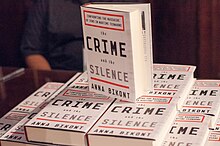The Crime and the Silence: Confronting the Massacre of Jews in Wartime Jedwabne is a 2004 book by Polish journalist Anna Bikont on the Jedwabne massacre, a 1941 pogrom of Polish Jews in Jedwabne, German-occupied Poland.
 | |
| Author | Anna Bikont |
|---|---|
| Original title | My z Jedwabnego |
| Language | Polish |
| Subject | Jedwabne pogrom |
| Genre | Journalistic investigation, historical studies |
| Publisher | Prószyński i S-ka |
Publication date | 2004 |
| Pages | 417 |
| Awards | European Book Prize (2011) |
| ISBN | 9788373376946 |
Content
editThe book was first published in Polish as My z Jedwabnego (2004, "Jedwabne: Battlefield of Memory").[1][2] It was next published in French under the title Le Crime et le Silence: Jedwabne 1941, la mémoire d'un pogrom dans la Pologne d'aujourd'hui (2011) which won the European Book Prize.[3] The English translation by Alissa Valles was published in 2015.[1][4] Other translations include: in Swedish as Vi från Jedwabne (2015); in Hebrew as Anaḥnu mi-Yedṿabneh : ha-peshaʻ ṿe-ha-hashtaḳah (2016); in Dutch as De misdaad en het zwijgen : Jedwabne 1941, de levende herinnering aan een pogrom in Polen (2016); in Chinese as Zui xing yu chen mo : Zhi mian ye de wa bu nei you tai ren da tu sha (2018); in Italian as Il crimine e il silenzio: Jedwabne 1941 - Un massacro in cerca di verità (2019), and; in German as Wir aus Jedwabne: Polen und Juden während der Shoah (2020).
In writing her book Bikont was inspired by Jan. T. Gross' pioneering study on the subject (Neighbors: The Destruction of the Jewish Community in Jedwabne, Poland, 2001). One of the novel areas she explores is the reaction of Jedwabne villagers to Gross' revelations, what one of the reviewers called "the early stage of the Jedwabne debate".[5] One of the themes of her book is the lingering antisemitism present in modern-day Jedwabne, where a number of inhabitants were unwilling to take part in her research project and yet others were afraid to be seen speaking to her.[1][2][6] Readings of her book in Poland have been picketed by Polish nationalists.[7]
The book is structured with interposing chapters of Bikont's diary (written in the years 2000–2003) and journalistic reportage.[6][8] Pursuing some leads and interviews, Bikont traveled among others to United States, Israel, Costa Rica and Argentina.[1][6]
Reception
editLouis Begley in his review for The New York Times wrote that the book is "beautifully written, devastating and very important".[1] A reviewer for The Guardian likewise called the book "a powerful and important study of the poisonous effects of racism and hatred within a community".[4] Sinclair McKay reviewing the book for The Telegraph noted that the book "is a hauntingly human study of the nightmare of persecution", though criticized it for insufficient historical background and lacking a map that many readers would find useful.[2]
Joanna Michlic reviewed the Polish edition, praising it as "a first-class journalistic account" recommended for students, scholars of the 20th century genocides as well as to those interested in the Polish-Jewish history, noting that the book's main contribution is to be found in the "investigation of contemporary memory of these crimes" among the survivors, perpetrators, rescuers and their descendants. She calls the book "an anthropological and a psychological study of a deeply troubling memory of the darkest crimes in the history of Polish-Jewish relations" and notes that while the author is a journalist, it is an exemplary journalistic study that is valuable to scholars pursuing historical studies in this topic area.[5]
Yves Gounin reviewed the French edition for Médiations. He compared the book to The Lost: A Search for Six of Six Million by Daniel Mendelsohn, noting that Bikont's account in French unfortunately suffers from translation problems.[8]
Reviewing the book for the Jewish Quarterly, Jennifer Weisberg calls the book a "masterpiece", praising Bikont for her efforts to gather numerous testimonies from surviving witnesses.[6]
References
edit- ^ a b c d e Begley, Louis (2015-11-04). "'The Crime and the Silence,' by Anna Bikont". The New York Times. ISSN 0362-4331. Retrieved 2020-04-28.
- ^ a b c Mckay, Sinclair (16 October 2015). "The Crime and the Silence by Anna Bikont, review: 'a clammy, frightening read'". The Telegraph. Retrieved 2020-04-28.
- ^ Barnes, Julian (16 December 2011). "Judging the European Book prize for 2011". The Guardian.
- ^ a b Smith, P. D. (2016-10-07). "The Crime and the Silence by Anna Bikont review – what exactly happened at Jedwabne". The Guardian. ISSN 0261-3077. Retrieved 2020-04-28.
- ^ a b Joanna Michlic (31 March 2009). "Anna Bikont, My z Jedwabnego (We from Jedwabne). Warsaw: Prószyński i S-ka SA, 2004. 417 pp". In Ezra Mendelsohn (ed.). Jews and the Sporting Life: Studies in Contemporary Jewry XXIII. Oxford University Press. pp. 12–. ISBN 978-0-19-972479-6.
- ^ a b c d Weisberg, Jennifer (2016-01-02). "The Crime and the Silence". Jewish Quarterly. 63 (1): 81. doi:10.1080/0449010X.2016.1162471. ISSN 0449-010X.
- ^ "When civilization fails". World Literature Today. 91 (1): 6. 2017. doi:10.7588/worllitetoda.91.1.0006.
- ^ a b Gounin, Yves (2012). "Review of Le Crime et le Silence: Jedwabne 1941, la mémoire d'un pogrom dans la Pologne d'aujourd'hui, " Médiations "". Vingtième Siècle. Revue d'histoire (114): 264–265. ISSN 0294-1759. JSTOR 23326340.
External links
edit- Podbielska, Alicja (2009). "Różnie to bowiem bywa z sąsiadami. "Czarne eufemizmy" w My z Jedwabnego Anny Bikont". Societas/Communitas (in Polish). 8 (2): 245–258. ISSN 1895-6890.
- Milas-Frankowski, Jan (2019). ""To syjonistyczne wychowanie dało mi siłę, by nie stać się owcą potulnie idącą na rzeź": opowieść o ocaleniu Awigdora Kochawa w "My Jedwabnego" Anny Bikont". In Jarosław Ławski; Ewelina Feldman-Kołodziejuk (eds.). Żydzi Wschodniej Polski, ser. 7, Między Odessą a Wilnem: wokół idei syjonizmu. Colloquia Orientalia Bialostocensia (in Polish). Białystok: Książnica Podlaska. ISBN 978-83-7657-317-5.
- Salner, Peter (2010). "Bikont, A.: My z Jedwabneho". Slovenský Národopis (in Slovak). 58 (1): 118. ISSN 1335-1303.
- (in Finnish) Ketola, Mikko. "The crime and the silence:[kirja-arvostelu]." Suomen kirkkohistoriallisen seuran vuosikirja 106 (2016). (book review)